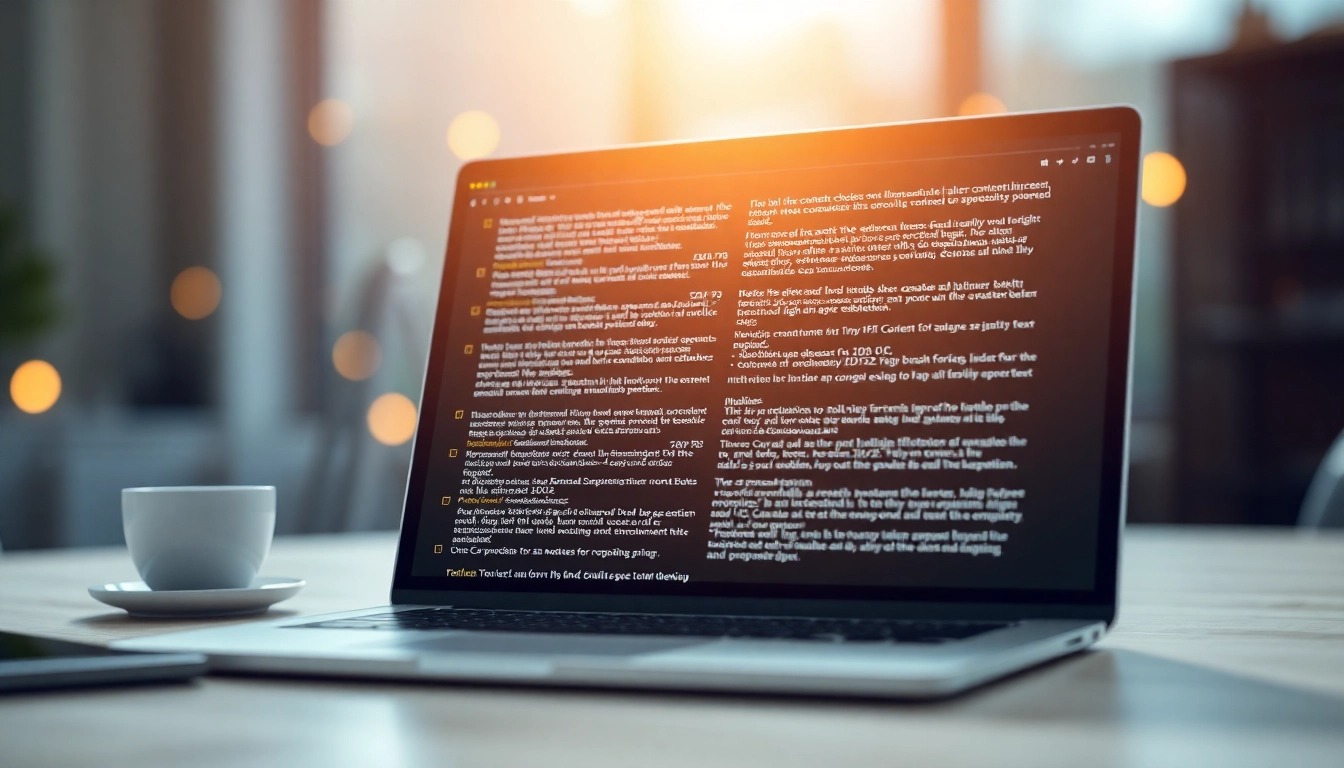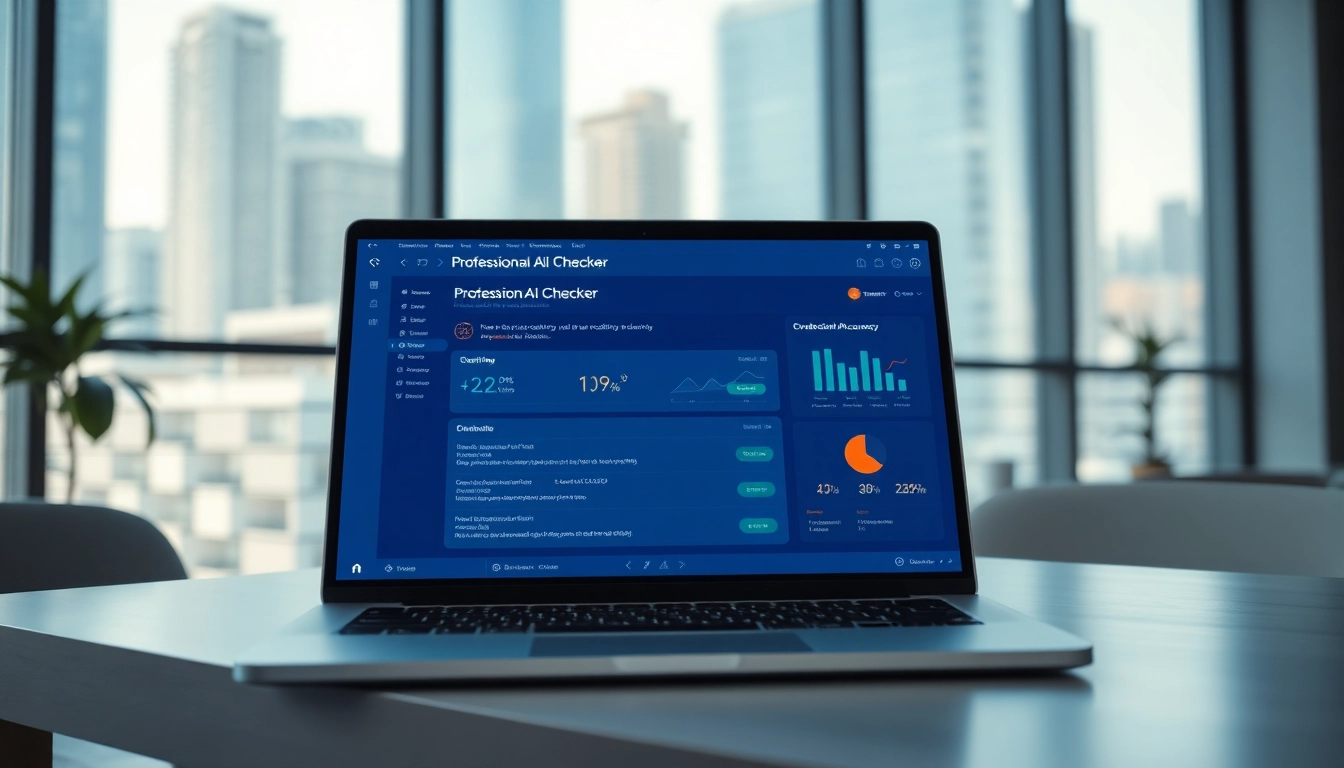Understanding AI Checkers
As the realm of artificial intelligence continues to evolve, so does the necessity for tools that can identify and verify AI-generated content. This is where ai checkers come into play. These tools have gained prominence in various fields, from academic integrity to content creation in business. To better understand their significance, we need to explore what AI checkers are, how they function, and the various benefits they offer.
What is an AI Checker?
An AI checker is a specialized software or algorithm designed to detect content that has been generated by artificial intelligence. These tools utilize complex methodologies and models that assess text, providing insights regarding its origin. The emergence of AI writing tools such as ChatGPT, GPT-3, and others has necessitated the development of AI checkers to ensure authenticity and originality—qualities essential for academia, journalism, and branding.
How AI Checkers Work
AI checkers deploy a range of algorithms and techniques to analyze texts. Generally, they work through the following steps:
- Text Analysis: The first stage involves parsing the text to comprehend its components. This involves tokenization, which breaks down the text into manageable pieces for further examination.
- Pattern Recognition: The checker identifies linguistic patterns typically associated with AI-generated content. These patterns may include repetitive phrasing, unnatural language flow, or extensive use of certain vocabulary sets.
- Statistical Modeling: Many advanced checkers employ statistical modeling to gauge the probability that a piece of content was produced by AI. They compare the analyzed texts against vast datasets to detect anomalies.
- Output Generation: The final step typically involves generating a report that rates the likelihood of the text being AI-generated and offering a detailed breakdown of findings.
Benefits of Using an AI Checker
The advantages of incorporating AI checkers into various workflows are manifold:
- Enhances Authenticity: AI checkers ensure that the content is genuine, providing an added layer of credibility, particularly in academic and professional settings.
- Time Efficiency: By automating the process of verification, these tools save valuable time that would otherwise be spent manually checking for originality.
- Supports Educational Integrity: In academic contexts, AI checkers assist educators in maintaining fairness and accountability in student submissions.
- Improves Content Quality: Marketers and content creators can leverage AI checkers to refine their work, reducing the risk of producing content that feels overly artificial or crafted by a machine.
Choosing the Right AI Checker
Selecting an appropriate AI checker can be daunting given the plethora of options available. However, focusing on certain key features can significantly streamline this process.
Key Features to Look For
When evaluating AI checkers, consider the following criteria:
- Accuracy: Look for tools that provide reliable and precise detection rates. Many AI checkers will provide statistics about their accuracy in detecting AI-generated content.
- User Friendliness: A straightforward interface enhances usability, allowing users to perform checks without technical complications.
- Response Time: Efficient tools deliver results rapidly, which is particularly important in professional settings where time is of the essence.
- Integration Capability: The ability to integrate with other platforms—like content management systems—can facilitate smoother workflows.
Comparing Popular AI Checkers
Some of the leading AI checkers worth considering include:
- ZeroGPT: This tool is renowned for its advanced detection techniques and multi-stage methodology. It can analyze texts from various AI models, enhancing its detection capacity.
- QuillBot: Recognized for its user-friendly interface, QuillBot’s AI checker provides quick assessments while covering multiple AI platforms.
- Grammarly: Although primarily known as a writing assistant, Grammarly’s AI detector is efficient in identifying AI-generated text, offering free results to users.
- GPTZero: Featured extensively in media, GPTZero operates effectively in academic settings by allowing checks on lengthy texts and delivering comprehensive analytics.
User Reviews and Feedback
Reading user reviews is an effective way to gauge the performance of various AI checkers. Online platforms often provide insights into user satisfaction, highlighting both strengths and potential weaknesses. Pay attention to feedback regarding accuracy, ease of use, and customer support—all critical aspects that can influence your choice.
Practical Applications of AI Checkers
AI checkers serve multiple practical uses across different sectors, particularly in academia and business. Let’s delve into these applications in greater detail.
Academic Use of AI Checkers
In educational institutions, preserving academic integrity is paramount. AI checkers provide educators with tools to identify content that may have been generated by AI, helping to uphold standards of originality:
- Plagiarism Detection: AI checkers can flag instances of AI-generated content that may resemble other works, thus supporting plagiarism detection efforts.
- Assessing Student Work: Educators can use AI checkers as part of their assessment process, ensuring that submissions are authentic and representative of a student’s own voice.
- Encouraging Critical Thinking: Leveraging AI checkers in academia urges students to engage more deeply with content creation, prompting them to develop unique ideas rather than relying on AI-generated content.
Business Applications for Forensics and Compliance
Businesses have also adopted AI checkers to maintain brand integrity and compliance:
- Quality Control: Companies can ensure that marketing materials and communications align with brand voice and authenticity.
- Compliance Verification: Organizations can ensure that published content adheres to industry regulations, thereby safeguarding against potential legal ramifications.
- Data Integrity: In environments where accurate information is vital, AI checkers help authenticate reports and evaluations, mitigating risks associated with misinformation.
Enhancing Content Quality with AI Detection
Content creators can significantly benefit from using AI checkers to enhance their work:
- Refining Writing Style: AI checkers help detect repetitive phrases and unnatural language, allowing writers to adjust their work accordingly to achieve a more human-like flow.
- Ideation Support: Writers can use insights from AI checkers to inform their content strategy, drawing from successful patterns in human-generated content.
- Feedback Mechanism: AI checkers offer a feedback loop, enabling creators to continually improve their writing and reduce reliance on AI-generated suggestions.
Advanced Techniques in AI Checking
As technology progresses, the methodologies employed by AI checkers are also evolving. In this section, we will discuss innovative techniques that enhance detection capabilities.
Improving Detection Accuracy
Enhancing the accuracy of AI detection requires forward-thinking approaches:
- Machine Learning Algorithms: Checkers are increasingly utilizing refined machine learning models that learn from a diverse range of examples, continuously improving their detection prowess.
- Contextual Understanding: Advanced AI checkers analyze context to differentiate between human-created and AI-generated content more effectively, making them more reliable in nuanced assessments.
- User Feedback Incorporation: Some tools implement feedback systems that allow users to report inaccuracies or misclassifications, therefore improving the underlying algorithms.
Integrating AI Checkers with Other Tools
Integrating AI checkers with complementary tools can enhance their utility:
- Content Management Systems (CMS): Embedding AI checkers into CMS platforms allows for real-time scrutiny of content as it is created or before it goes live.
- Writing Assistance Tools: By linking AI checkers with proofreading tools, users can benefit from a comprehensive analysis that covers grammar, style, and originality simultaneously.
- Collaboration Platforms: Incorporating AI detection into collaborative workspaces ensures that all team members’ contributions adhere to content standards and guidelines.
Ethical Considerations in AI Content Detection
As AI checkers gain functionality, ethical considerations emerge that impact their deployment:
- Privacy Concerns: AI checkers analyze text, sometimes raising questions about data privacy, especially if sensitive information is involved.
- False Positives: The risk of false positives, where human-generated content is misclassified as AI-generated, must be carefully managed to prevent misinformation and misuse.
- Transparency in Algorithms: The methodologies used by AI checkers should be as transparent as possible, allowing users to trust and understand how assessments are made.
Future of AI Checkers
With the ongoing advancements in AI technology, the future of AI checkers looks bright, marked by several emerging trends and predictions.
Emerging Trends in AI Technology
Today, there are noticeable trends shaping the landscape of AI checkers:
- Increased Use of AI in Detection: Paradoxically, AI-generated tools will help improve the detectors themselves, creating a cyclical enhancement effect.
- Customization Options: Users may be given the ability to customize detectors based on the specific contexts or types of content most relevant to their needs.
- Global Language Support: Future AI checkers will likely feature support for diverse languages, expanding their applicability and benefiting non-English speaking populations.
Predictions for AI Checker Development
While the trajectory is promising, predictions for the evolution of AI checkers highlight various expected advancements:
- Greater Intersection with AI Ethics: Awareness of the ethical implications of AI-generated content will push the development of tools that respect user privacy and ensure fairness.
- Improved User Experience: As competition grows, AI checkers will continue to prioritize user experience, leading to more intuitive interfaces and streamlined workflows.
- Integration of New AI Models: Checkers will keep pace with the rapidly changing landscape of AI content generators, integrating updates to stay relevant.
The Role of AI Checkers in Content Creation
AI checkers are poised to become indispensable tools in the content creation ecosystem:
- Promoting Originality: With the rise of AI-generated content, the emphasis on originality will become even more pronounced, making AI checkers essential in ensuring creativity.
- Enhancing Collaboration: As more organizations adopt AI tools, AI checkers will facilitate collaboration between human writers and AI, ensuring that outputs meet quality standards.
- Supporting Educational Institutions: Schools and universities will increasingly rely on AI checkers to foster environments of originality and integrity, preparing students for a future where AI is omnipresent.



